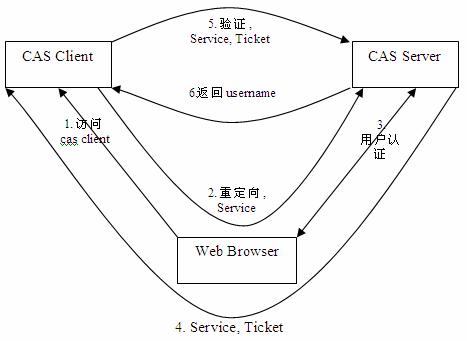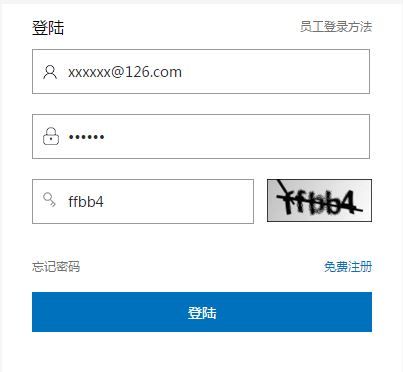CAS 原理和协议
基础模式
基础模式 SSO 访问流程主要有以下步骤:
1. 访问服务: SSO 客户端发送请求访问应用系统提供的服务资源。
2. 定向认证: SSO 客户端会重定向用户请求到 SSO 服务器。
3. 用户认证:用户身份认证。
4. 发放票据: SSO 服务器会产生一个随机的 Service Ticket 。
5. 验证票据: SSO 服务器验证票据 Service Ticket 的合法性,验证通过后,允许客户端访问服务。
6. 传输用户信息: SSO 服务器验证票据通过后,传输用户认证结果信息给客户端。
下面是 CAS 最基本的协议过程:
基础协议图
如 上图: CAS Client 与受保护的客户端应用部署在一起,以 Filter 方式保护 Web 应用的受保护资源,过滤从客户端过来的每一个 Web 请求,同 时, CAS Client 会分析 HTTP 请求中是否包含请求 Service Ticket( ST 上图中的 Ticket) ,如果没有,则说明该用户是没有经过认证的;于是 CAS Client 会重定向用户请求到 CAS Server ( Step 2 ),并传递 Service (要访问的目的资源地址)。 Step 3 是用户认证过程,如果用户提供了正确的 Credentials , CAS Server 随机产生一个相当长度、唯一、不可伪造的 Service Ticket ,并缓存以待将来验证,并且重定向用户到 Service 所在地址(附带刚才产生的 Service Ticket ) , 并为客户端浏览器设置一个 Ticket Granted Cookie ( TGC ) ; CAS Client 在拿到 Service 和新产生的 Ticket 过后,在 Step 5 和 Step6 中与 CAS Server 进行身份核实,以确保 Service Ticket 的合法性。
在该协议中,所有与 CAS Server 的交互均采用 SSL 协议,以确保 ST 和 TGC 的安全性。协议工作过程中会有 2 次重定向 的过程。但是 CAS Client 与 CAS Server 之间进行 Ticket 验证的过程对于用户是透明的(使用 HttpsURLConnection )。
CAS 请求认证时序图如下:
CAS 如何实现 SSO
当用户访问另一个应用的服务再次被重定向到 CAS Server 的时候, CAS Server 会主动获到这个 TGC cookie ,然后做下面的事情:
1) 如果 User 持有 TGC 且其还没失效,那么就走基础协议图的 Step4 ,达到了 SSO 的效果;
2) 如果 TGC 失效,那么用户还是要重新认证 ( 走基础协议图的 Step3) 。
以上是在网络上找到的相关描述,详细请参考:
http://www.open-open.com/lib/view/open1432381488005.html
但是光看文字描述还是不够清晰,不如Debug来看一下。
----------------------------------------------------------------------------------
前提:
有两个web应用
app1.testcas.com
app2.testcas.com
Cas认证中心
demo.testcas.com
第一步:访问目标应用app1
如果想要访问app1的网页
例如:app1.testcas.com/user/doWelcome
这时,该请求将会被事先配置好的CAS Filter所拦截
app1的web.xml配置如下:
<filter> <filter-name>CAS Filterfilter-name> <filter-class>org.jasig.cas.client.authentication.AuthenticationFilterfilter-class> <init-param> <param-name>casServerLoginUrlparam-name> <param-value>https://demo.testcas.com/cas/loginparam-value> init-param> <init-param> <param-name>serverNameparam-name> <param-value>http://app1.testcas.comparam-value> init-param> filter> <filter-mapping> <filter-name>CAS Filterfilter-name> <url-pattern>/*url-pattern> filter-mapping>
断点进入该类的doFilter方法
org.jasig.cas.client.authentication.AuthenticationFilter > doFilter
public final void doFilter(final ServletRequest servletRequest, final ServletResponse servletResponse, final FilterChain filterChain) throws IOException, ServletException { final HttpServletRequest request = (HttpServletRequest) servletRequest; final HttpServletResponse response = (HttpServletResponse) servletResponse; final HttpSession session = request.getSession(false); // 该变量为判断用户是否已经登录的标记,在用户成功登录后会被设置 final Assertion assertion = session != null ? (Assertion) session.getAttribute(CONST_CAS_ASSERTION) : null; // 判断是否登录过,如果已经登录过,进入if并且退出 if (assertion != null) { filterChain.doFilter(request, response); return; } // 如果没有登录过,继续后续处理 // 构造访问的URL,如果该Url包含tikicet参数,则去除参数 final String serviceUrl = constructServiceUrl(request, response); // 如果ticket存在,则获取URL后面的参数ticket final String ticket = CommonUtils.safeGetParameter(request, getArtifactParameterName()); // 研究中 final boolean wasGatewayed = this.gatewayStorage.hasGatewayedAlready(request, serviceUrl); // 如果ticket存在 if (CommonUtils.isNotBlank(ticket) || wasGatewayed) { filterChain.doFilter(request, response); return; } final String modifiedServiceUrl; log.debug("no ticket and no assertion found"); if (this.gateway) { log.debug("setting gateway attribute in session"); modifiedServiceUrl = this.gatewayStorage.storeGatewayInformation(request, serviceUrl); } else { modifiedServiceUrl = serviceUrl; } if (log.isDebugEnabled()) { log.debug("Constructed service url: " + modifiedServiceUrl); } // 如果用户没有登录过,那么构造重定向的URL final String urlToRedirectTo = CommonUtils.constructRedirectUrl(this.casServerLoginUrl, getServiceParameterName(), modifiedServiceUrl, this.renew, this.gateway); if (log.isDebugEnabled()) { log.debug("redirecting to \"" + urlToRedirectTo + "\""); } // 重定向跳转到Cas认证中心 response.sendRedirect(urlToRedirectTo); }
第二步:请求被重定向到CAS服务器端后
根据CAS_Server端的login-webflow.xml配置
xml version="1.0" encoding="UTF-8"?>
<flow xmlns="http://www.springframework.org/schema/webflow"
xmlns:xsi="http://www.w3.org/2001/XMLSchema-instance"
xsi:schemaLocation="http://www.springframework.org/schema/webflow
http://www.springframework.org/schema/webflow/spring-webflow-2.0.xsd">
<var name="credentials"
class="org.jasig.cas.authentication.principal.UsernamePasswordCredentials" />
<on-start>
<evaluate expression="initialFlowSetupAction" />
on-start>
<decision-state id="ticketGrantingTicketExistsCheck">
<if test="flowScope.ticketGrantingTicketId neq null" then="hasServiceCheck"
else="gatewayRequestCheck" />
decision-state>
<decision-state id="gatewayRequestCheck">
<if
test="externalContext.requestParameterMap['gateway'] neq '' && externalContext.requestParameterMap['gateway'] neq null && flowScope.service neq null"
then="gatewayServicesManagementCheck" else="generateLoginTicket" />
decision-state>
<decision-state id="hasServiceCheck">
<if test="flowScope.service != null" then="renewRequestCheck" else="viewGenericLoginSuccess" />
decision-state>
<decision-state id="renewRequestCheck">
<if
test="externalContext.requestParameterMap['renew'] neq '' && externalContext.requestParameterMap['renew'] neq null"
then="generateLoginTicket" else="generateServiceTicket" />
decision-state>
<decision-state id="warn">
<if test="flowScope.warnCookieValue" then="showWarningView" else="redirect" />
decision-state>
<action-state id="generateLoginTicket">
<evaluate expression="generateLoginTicketAction.generate(flowRequestContext)" />
<transition on="success" to="viewLoginForm" />
action-state>
<view-state id="viewLoginForm" view="casMyLoginView" model="credentials">
<binder>
<binding property="username" />
<binding property="password" />
<binding property="imgverifycode" />
binder>
<on-entry>
<set name="viewScope.commandName" value="'credentials'" />
on-entry>
<transition on="submit" bind="true" validate="true" to="imgverifycodeValidate">
<evaluate
expression="authenticationViaFormAction.doBind(flowRequestContext, flowScope.credentials)" />
transition>
view-state>
<action-state id="imgverifycodeValidate">
<evaluate
expression="authenticationViaFormAction.validatorCode(flowRequestContext, flowScope.credentials, messageContext)" />
<transition on="error" to="generateLoginTicket" />
<transition on="success" to="realSubmit" />
action-state>
<action-state id="realSubmit">
<evaluate
expression="authenticationViaFormAction.submit(flowRequestContext, flowScope.credentials, messageContext)" />
<transition on="warn" to="warn" />
<transition on="success" to="sendTicketGrantingTicket" />
<transition on="error" to="generateLoginTicket" />
action-state>
<action-state id="sendTicketGrantingTicket">
<evaluate expression="sendTicketGrantingTicketAction" />
<transition to="serviceCheck" />
action-state>
<decision-state id="serviceCheck">
<if test="flowScope.service neq null" then="generateServiceTicket"
else="viewGenericLoginSuccess" />
decision-state>
<action-state id="generateServiceTicket">
<evaluate expression="generateServiceTicketAction" />
<transition on="success" to="warn" />
<transition on="error" to="generateLoginTicket" />
<transition on="gateway" to="gatewayServicesManagementCheck" />
action-state>
<action-state id="gatewayServicesManagementCheck">
<evaluate expression="gatewayServicesManagementCheck" />
<transition on="success" to="redirect" />
action-state>
<action-state id="redirect">
<evaluate
expression="flowScope.service.getResponse(requestScope.serviceTicketId)"
result-type="org.jasig.cas.authentication.principal.Response" result="requestScope.response" />
<transition to="postRedirectDecision" />
action-state>
<decision-state id="postRedirectDecision">
<if test="requestScope.response.responseType.name() eq 'POST'"
then="postView" else="redirectView" />
decision-state>
<end-state id="viewGenericLoginSuccess" view="casLoginGenericSuccessView" />
<end-state id="showWarningView" view="casLoginConfirmView" />
<end-state id="postView" view="postResponseView">
<on-entry>
<set name="requestScope.parameters" value="requestScope.response.attributes" />
<set name="requestScope.originalUrl" value="flowScope.service.id" />
on-entry>
end-state>
<end-state id="redirectView" view="externalRedirect:${requestScope.response.url}" />
<end-state id="viewServiceErrorView" view="viewServiceErrorView" />
<end-state id="viewServiceSsoErrorView" view="viewServiceSsoErrorView" />
<global-transitions>
<transition to="viewServiceErrorView"
on-exception="org.springframework.webflow.execution.repository.NoSuchFlowExecutionException" />
<transition to="viewServiceSsoErrorView"
on-exception="org.jasig.cas.services.UnauthorizedSsoServiceException" />
<transition to="viewServiceErrorView"
on-exception="org.jasig.cas.services.UnauthorizedServiceException" />
global-transitions>
flow>
首先会进入initialFlowSetupAction
protected Event doExecute(final RequestContext context) throws Exception { final HttpServletRequest request = WebUtils.getHttpServletRequest(context); if (!this.pathPopulated) { final String contextPath = context.getExternalContext().getContextPath(); final String cookiePath = StringUtils.hasText(contextPath) ? contextPath + "/" : "/"; logger.info("Setting path for cookies to: " + cookiePath); this.warnCookieGenerator.setCookiePath(cookiePath); this.ticketGrantingTicketCookieGenerator.setCookiePath(cookiePath); this.pathPopulated = true; } // 获取客户端的名为CASTGC的cookie context.getFlowScope().put( "ticketGrantingTicketId", this.ticketGrantingTicketCookieGenerator.retrieveCookieValue(request)); context.getFlowScope().put( "warnCookieValue", Boolean.valueOf(this.warnCookieGenerator.retrieveCookieValue(request))); // 获取要访问的服务 final Service service = WebUtils.getService(this.argumentExtractors, context); if (service != null && logger.isDebugEnabled()) { logger.debug("Placing service in FlowScope: " + service.getId()); } context.getFlowScope().put("service", service); return result("success"); }
之后根据webflow流程,主要有两大分歧
如果TGC并且service存在,则发放ST(service ticket)并重定向回到客户端应用
如果首次访问,TGC不存在,则跳转到CAS-server的登录页面,如下(本登录页面是重新绘制,不是CAS原生登录页)
因为我是首次登录,所以会跳转到该登录页进行认证。
第三步:用户认证
输入用户名、密码、验证码,点击登录
这时再来看login-webflow.xml
用户提交登录后,按流程依次是
1.authenticationViaFormAction.doBind
<view-state id="viewLoginForm" view="casMyLoginView" model="credentials"> <binder> <binding property="username" /> <binding property="password" /> <binding property="imgverifycode" /> binder> <on-entry> <set name="viewScope.commandName" value="'credentials'" /> on-entry> <transition on="submit" bind="true" validate="true" to="imgverifycodeValidate"> <evaluate expression="authenticationViaFormAction.doBind(flowRequestContext, flowScope.credentials)" /> transition> view-state>
=>
2.imgverifycodeValidate(验证码处理为自定义的处理,不是原生逻辑)
<action-state id="imgverifycodeValidate"> <evaluate expression="authenticationViaFormAction.validatorCode(flowRequestContext, flowScope.credentials, messageContext)" /> <transition on="error" to="generateLoginTicket" /> <transition on="success" to="realSubmit" /> action-state>
=>
3.realSubmit
<action-state id="realSubmit"> <evaluate expression="authenticationViaFormAction.submit(flowRequestContext, flowScope.credentials, messageContext)" /> <transition on="warn" to="warn" /> <transition on="success" to="sendTicketGrantingTicket" /> <transition on="error" to="generateLoginTicket" /> action-state>
realSubmit中执行的是authenticationViaFormAction.submit
public final String submit(final RequestContext context, final Credentials credentials, final MessageContext messageContext) throws Exception { // Validate login ticket final String authoritativeLoginTicket = WebUtils.getLoginTicketFromFlowScope(context); final String providedLoginTicket = WebUtils.getLoginTicketFromRequest(context); if (!authoritativeLoginTicket.equals(providedLoginTicket)) { this.logger.warn("Invalid login ticket " + providedLoginTicket); final String code = "INVALID_TICKET"; messageContext.addMessage(new MessageBuilder().error() .code(code) .arg(providedLoginTicket) .defaultText(code) .build()); return "error"; } // 获取TGT,首次登录的话应该是不存在的,所以直接跳过该分歧 final String ticketGrantingTicketId = WebUtils.getTicketGrantingTicketId(context); final Service service = WebUtils.getService(context); if (StringUtils.hasText(context.getRequestParameters().get("renew")) && ticketGrantingTicketId != null && service != null) { try { final String serviceTicketId = this.centralAuthenticationService.grantServiceTicket(ticketGrantingTicketId, service, credentials); WebUtils.putServiceTicketInRequestScope(context, serviceTicketId); putWarnCookieIfRequestParameterPresent(context); return "warn"; } catch (final TicketException e) { if (e.getCause() != null && AuthenticationException.class.isAssignableFrom(e.getCause() .getClass())) { populateErrorsInstance(e, messageContext); return "error"; } this.centralAuthenticationService.destroyTicketGrantingTicket(ticketGrantingTicketId); if (logger.isDebugEnabled()) { logger.debug("Attempted to generate a ServiceTicket using renew=true with different credentials", e); } } } try { // 首次登录时,用户输入信息验证成功后,创建一个新的TGT WebUtils.putTicketGrantingTicketInRequestScope(context, this.centralAuthenticationService.createTicketGrantingTicket(credentials)); putWarnCookieIfRequestParameterPresent(context); return "success"; } catch (final TicketException e) { // 如果用户输入信息验证不通过,会抛出异常,并在页面上显示 populateErrorsInstance(e, messageContext); return "error"; } }
=>
4.用户信息认证通过,并且创建了新的TGT后,缓存TGT,并且生成cookie,待后续把cookie写入客户端
<action-state id="sendTicketGrantingTicket"> <evaluate expression="sendTicketGrantingTicketAction" /> <transition to="serviceCheck" /> action-state>
sendTicketGrantingTicketAction.doExecute
protected Event doExecute(final RequestContext context) { final String ticketGrantingTicketId = WebUtils.getTicketGrantingTicketId(context); final String ticketGrantingTicketValueFromCookie = (String) context.getFlowScope().get("ticketGrantingTicketId"); if (ticketGrantingTicketId == null) { return success(); } // 生成Cookie并且写入response,最终在客户端Cookie中保存了本TGT this.ticketGrantingTicketCookieGenerator.addCookie(WebUtils.getHttpServletRequest(context), WebUtils .getHttpServletResponse(context), ticketGrantingTicketId); if (ticketGrantingTicketValueFromCookie != null && !ticketGrantingTicketId.equals(ticketGrantingTicketValueFromCookie)) { this.centralAuthenticationService .destroyTicketGrantingTicket(ticketGrantingTicketValueFromCookie); } return success(); }
=>
5. 然后验证是否存在Service,如果存在,生成ST,重定向用户到 Service 所在地址(附带该ST ) , 并为客户端浏览器设置一个 Ticket Granted Cookie ( TGC )
serviceCheck => generateServiceTicket => warn => redirect =>postRedirectDecision
第四步:拿着新产生的ST,到 CAS Server 进行身份核实,以确保 Service Ticket 的合法性。
当cas Service重定向到客户端所在service时,该重定向请求同样会被客户端配置的过滤器所拦截,又进入了第一步处的AuthenticationFilter
但是由于本次请求已经带回了ST(service ticket),所以处理与首次有所不同。
public final void doFilter(final ServletRequest servletRequest, final ServletResponse servletResponse, final FilterChain filterChain) throws IOException, ServletException { final HttpServletRequest request = (HttpServletRequest) servletRequest; final HttpServletResponse response = (HttpServletResponse) servletResponse; final HttpSession session = request.getSession(false); final Assertion assertion = session != null ? (Assertion) session.getAttribute(CONST_CAS_ASSERTION) : null; if (assertion != null) { filterChain.doFilter(request, response); return; } final String serviceUrl = constructServiceUrl(request, response); final String ticket = CommonUtils.safeGetParameter(request, getArtifactParameterName()); final boolean wasGatewayed = this.gatewayStorage.hasGatewayedAlready(request, serviceUrl); // 由于本次已经可以取到cas service返回的新的service ticket if (CommonUtils.isNotBlank(ticket) || wasGatewayed) {
// 所以直接进入本代码块,然后退出 filterChain.doFilter(request, response); return; } // 不会再一次被重定向会cas 认证中心
final String modifiedServiceUrl; log.debug("no ticket and no assertion found"); if (this.gateway) { log.debug("setting gateway attribute in session"); modifiedServiceUrl = this.gatewayStorage.storeGatewayInformation(request, serviceUrl); } else { modifiedServiceUrl = serviceUrl; } if (log.isDebugEnabled()) { log.debug("Constructed service url: " + modifiedServiceUrl); } // 如果用户没有登录过,那么构造重定向的URL final String urlToRedirectTo = CommonUtils.constructRedirectUrl(this.casServerLoginUrl, getServiceParameterName(), modifiedServiceUrl, this.renew, this.gateway); if (log.isDebugEnabled()) { log.debug("redirecting to \"" + urlToRedirectTo + "\""); } // 重定向跳转到Cas认证中心 response.sendRedirect(urlToRedirectTo); }
之后,又会被web.xml中的CAS Validation Filter(Cas20ProxyReceivingTicketValidationFilter)所拦截
该拦截器用来与CAS Server 进行身份核实,以确保 Service Ticket 的合法性
由于 Cas20ProxyReceivingTicketValidationFilter 没有重写doFilter方法,所以会进入父类AbstractTicketValidationFilter的doFilter方法
AbstractTicketValidationFilter.doFilter
public final void doFilter(final ServletRequest servletRequest, final ServletResponse servletResponse, final FilterChain filterChain) throws IOException, ServletException { if (!preFilter(servletRequest, servletResponse, filterChain)) { return; } final HttpServletRequest request = (HttpServletRequest) servletRequest; final HttpServletResponse response = (HttpServletResponse) servletResponse; final String ticket = CommonUtils.safeGetParameter(request, getArtifactParameterName()); if (CommonUtils.isNotBlank(ticket)) { if (log.isDebugEnabled()) { log.debug("Attempting to validate ticket: " + ticket); } try { // 构造验证URL,向cas server发起验证请求 final Assertion assertion = this.ticketValidator.validate(ticket, constructServiceUrl(request, response)); if (log.isDebugEnabled()) { log.debug("Successfully authenticated user: " + assertion.getPrincipal().getName()); } // 如果验证成功,设置assertion,当再一次发起访问请求时,如果发现assertion已经被设置,所以已经通过验证,不过再次重定向会cas认证中心 request.setAttribute(CONST_CAS_ASSERTION, assertion); if (this.useSession) { request.getSession().setAttribute(CONST_CAS_ASSERTION, assertion); } onSuccessfulValidation(request, response, assertion); if (this.redirectAfterValidation) { log.debug("Redirecting after successful ticket validation."); response.sendRedirect(constructServiceUrl(request, response)); return; } } catch (final TicketValidationException e) { response.setStatus(HttpServletResponse.SC_FORBIDDEN); log.warn(e, e); onFailedValidation(request, response); if (this.exceptionOnValidationFailure) { throw new ServletException(e); } return; } } filterChain.doFilter(request, response); }
this.ticketValidator.validate(..) 代码如下
public Assertion validate(final String ticket, final String service) throws TicketValidationException { // 生成验证URL,如果你debug会发现,此处会构造一个类似以下的URL,访问的是cas server的serviceValidate方法 // https://demo.testcas.com/cas/serviceValidate?ticket=ST-31-cioaDNxSpUWIgeYEn4yK-cas&service=http%3A%2F%2Fapp1.testcas.com%2Fb2c-haohai-server%2Fuser%2FcasLogin final String validationUrl = constructValidationUrl(ticket, service); if (log.isDebugEnabled()) { log.debug("Constructing validation url: " + validationUrl); } try { log.debug("Retrieving response from server."); // 得到cas service响应,验证成功或者失败 final String serverResponse = retrieveResponseFromServer(new URL( validationUrl), ticket); if (serverResponse == null) { throw new TicketValidationException( "The CAS server returned no response."); } if (log.isDebugEnabled()) { log.debug("Server response: " + serverResponse); } return parseResponseFromServer(serverResponse); } catch (final MalformedURLException e) { throw new TicketValidationException(e); } }
可以看一下,cas server侧的serverValidate的具体实现
在cas server的cas-servlet.xml中,可以看到如下配置:
<bean id="handlerMappingC" class="org.springframework.web.servlet.handler.SimpleUrlHandlerMapping"> <property name="mappings"> <props> <prop key="/logout"> logoutController prop> <prop key="/serviceValidate"> serviceValidateController prop>
...
指向serviceValidateController
ServiceValidateController.handleRequestInternal(...)
protected final ModelAndView handleRequestInternal(final HttpServletRequest request, final HttpServletResponse response) throws Exception { final WebApplicationService service = this.argumentExtractor.extractService(request); final String serviceTicketId = service != null ? service.getArtifactId() : null; if (service == null || serviceTicketId == null) { if (logger.isDebugEnabled()) { logger.debug(String.format("Could not process request; Service: %s, Service Ticket Id: %s", service, serviceTicketId)); } return generateErrorView("INVALID_REQUEST", "INVALID_REQUEST", null); } try { final Credentials serviceCredentials = getServiceCredentialsFromRequest(request); String proxyGrantingTicketId = null; // XXX should be able to validate AND THEN use if (serviceCredentials != null) { try { proxyGrantingTicketId = this.centralAuthenticationService .delegateTicketGrantingTicket(serviceTicketId, serviceCredentials); } catch (final TicketException e) { logger.error("TicketException generating ticket for: " + serviceCredentials, e); } } final Assertion assertion = this.centralAuthenticationService.validateServiceTicket(serviceTicketId, service); final ValidationSpecification validationSpecification = this.getCommandClass(); final ServletRequestDataBinder binder = new ServletRequestDataBinder(validationSpecification, "validationSpecification"); initBinder(request, binder); binder.bind(request); if (!validationSpecification.isSatisfiedBy(assertion)) { if (logger.isDebugEnabled()) { logger.debug("ServiceTicket [" + serviceTicketId + "] does not satisfy validation specification."); } return generateErrorView("INVALID_TICKET", "INVALID_TICKET_SPEC", null); } onSuccessfulValidation(serviceTicketId, assertion); final ModelAndView success = new ModelAndView(this.successView); success.addObject(MODEL_ASSERTION, assertion); if (serviceCredentials != null && proxyGrantingTicketId != null) { final String proxyIou = this.proxyHandler.handle(serviceCredentials, proxyGrantingTicketId); success.addObject(MODEL_PROXY_GRANTING_TICKET_IOU, proxyIou); } if (logger.isDebugEnabled()) { logger.debug(String.format("Successfully validated service ticket: %s", serviceTicketId)); } return success; } catch (final TicketValidationException e) { return generateErrorView(e.getCode(), e.getCode(), new Object[] {serviceTicketId, e.getOriginalService().getId(), service.getId()}); } catch (final TicketException te) { return generateErrorView(te.getCode(), te.getCode(), new Object[] {serviceTicketId}); } catch (final UnauthorizedServiceException e) { return generateErrorView(e.getMessage(), e.getMessage(), null); } }
验证成功后,就可以正常访问了。


